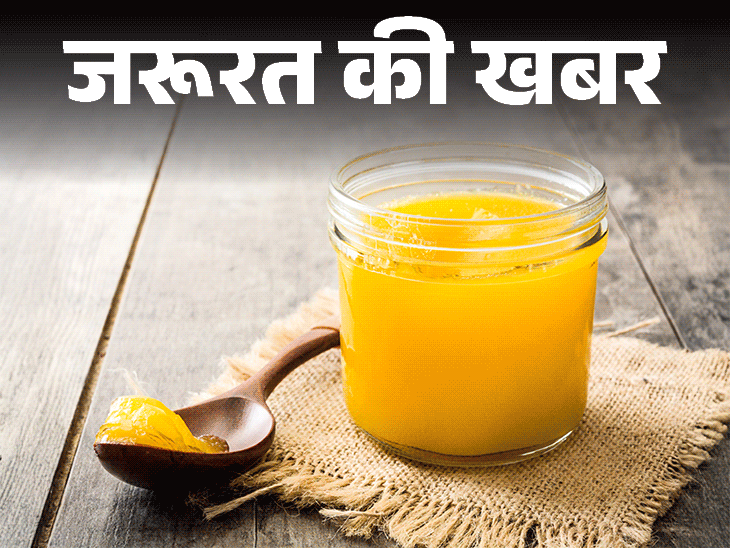2 minutes agoAuthor: Shivakant Shukla
- copy link

Who is not aware of the laddu controversy of the famous Tirupati temple of Andhra Pradesh. Samples of the ghee used in the temple’s Tirupati Laddu Prasadam were tested to contain foreign fat, including lard (pig fat), tallow (beef) and fish oil, as well as coconut, linseed, Contains rapeseed and cotton seed. This information came to light after complaints of change in the taste of Prasad, which has increased people’s concerns regarding the purity of ghee.
Questions are arising in everyone’s mind regarding the purity of ghee that whether we too are consuming adulterated ghee. so today ‘News of need’ In this article we will tell you about the ways to identify pure ghee at home. You will also know-
- How to make pure ghee at home?
- How beneficial is ghee for your health?
- Which elements are found in ghee?
Question- How to identify adulterated ghee at home?
answer- With increasing concerns about the quality of ghee, it is important to know how to test the purity of ghee at home. Here we are telling you about some simple methods by which you can check whether your ghee is real or fake.
taste the aroma
Pure ghee has a distinct, nutty aroma, which intensifies when heated. Artificial or adulterated ghee often does not have this aroma, which is an indication of it being adulterated.
test through color
Real cow’s ghee is light golden and yellow. It should not contain artificial colors. If ghee appears unusually shiny or does not have its natural color then it may be impure.
Look carefully at the texture of ghee
Pure ghee is smooth and creamy. It freezes slightly when refrigerated, but melts easily when heated. Sticky ghee indicates adulteration.
heat and check clarity
To check clarity, heat some ghee in a pan. Pure ghee remains clear and free from sediment. If some dirt settles at the bottom then there is a possibility of ghee being adulterated.
test by burning
Put one spoon ghee on hot pan. Pure ghee melts quickly without any residue and evaporates into smoke. Impure ghee may smell bad or leave a mess underneath.
refrigeration test
Pure ghee solidifies when refrigerated, but melts when kept at normal temperature. If it remains liquid even after refrigerating, then this ghee is fake and adulterated.
check with water
For this, first of all take a glass of water. Then put some ghee in it. If ghee floats in water then it is pure and if ghee sinks in water then it is adulterated.
Apart from this, Food Safety and Standards Authority of India (FSSAI) has also suggested two methods to test the purity of ghee. Understand this in the graphic below.

Question- What is the consumption of ghee and butter in India?
answer- According to a study published in the National Institute of Health, the per capita consumption of ghee and butter in India was 2.7 kg per year (7.4 g per person/day) in 2007, which increased to 4.48 kg per year (12.3 g per person) in the year 2020. person/per day).
Question- Which elements are found in ghee?
answer- Ghee mainly contains 99.5% fat and less than 0.5% moisture. Apart from this, ghee contains Vitamin A, Vitamin D, Vitamin E, Vitamin K and phospholipid. It also has antioxidant properties. Apart from this, minerals like calcium and omega 3 are also found in abundance in it. Overall, it is very beneficial for your health. It is also used in worship.
Question- What things should be kept in mind while buying ghee from the market?
answer- See the points given in the graphic below-

Question- What is the difference between ghee and butter?
answer- Ghee and butter are similar, but there is a difference in the way they are made. The process of making both is the same, but ghee is cooked a little more than butter, which makes it more tasty and nutritious. Besides, its color also becomes darker.
Question- Is consumption of ghee beneficial for health?
answer- Ghee is a rich source of vitamins, antioxidants and healthy fats. Experts say that fat should be consumed in limited quantities, but studies show that eating fatty foods like ghee provides the body with some essential vitamins and minerals. Cooking healthy foods and vegetables with ghee can provide more nutrients. However, consuming it in excessive amounts can also prove harmful. See the graphic below to see how ghee is beneficial for your health.

Easy way to make ghee at home
Since the arrival of adulterated ghee in the market, most people are afraid to buy it. If you are fond of eating ghee, then here we are telling you an easy way to make ghee at home. You can understand the entire process through the graphic below.

Question- How much quantity of ghee should I consume?
answer- Generally a healthy person can consume one or two teaspoons of ghee daily. A child above 2 years can also eat one or two spoons of ghee daily. Keep in mind that it is not easy to digest much ghee without hard work. Therefore, people who eat ghee should also pay attention to working hard.



